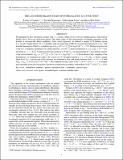| dc.contributor.author | Cooksey, Kathy | |
| dc.contributor.author | Prochaska, J. Xavier | |
| dc.contributor.author | Thom, Christopher | |
| dc.contributor.author | Chen, Hsiao-Wen | |
| dc.date.accessioned | 2015-03-05T14:55:30Z | |
| dc.date.available | 2015-03-05T14:55:30Z | |
| dc.date.issued | 2011-03 | |
| dc.date.submitted | 2010-11 | |
| dc.identifier.issn | 0004-637X | |
| dc.identifier.issn | 1538-4357 | |
| dc.identifier.uri | http://hdl.handle.net/1721.1/95836 | |
| dc.description.abstract | We identified 24 Si iv absorption systems with z ≾ 1 from a blind survey of 49 low-redshift quasars with archival Hubble Space Telescope ultraviolet spectra. We relied solely on the characteristic wavelength separation of the doublet to automatically detect candidates. After visual inspection, we defined a sample of 20 definite (group G = 1) and 4 “highly likely” (G = 2) doublets with rest equivalent widths Wr for both lines detected at ≥3σWr. The absorber line density of the G = 1doublets was dNSiiv/dX=1.4+0.4−0.3for log N(Si+3)>12. 9.The best-fit power law to the G = 1 frequency distribution of column densities f(N(Si+3)) had normalization k = (1.2+0.5−0.4)×10−14cm2 and slope α N=−16+0.3−0.3. Using the power-law model off(N(Si+3)), we measured the Si+3 mass density relative to the critical density: Si+3=(3.7+2.8−1.7)×10−8for 13logN(Si+3)15. From Monte Carlo sampling of the distributions, we estimated our value to be a factor of 4.8+3.0−1.9higher than the 2z4.5Si+3. From a simple linear fit to Si+3 over the age of the universe, we estimated a slow and steady increase from z=5.5→0 with dSi+3/d Ω age =(0.61±0.23)×10−8Gyr−1. We compared our ionic ratios N(Si+3)/N(C+3) to a 2<z<4.5 sample and concluded, from survival analysis, that the two populations are similar, with medianN(Si+3)/N(C+3) =0.16. | en_US |
| dc.description.sponsorship | United States. National Aeronautics and Space Administration (NASA contract NAS5-32985) | en_US |
| dc.description.sponsorship | Space Telescope Science Institute (U.S.) (NASA contract NAS 5-26555) | en_US |
| dc.description.sponsorship | Space Telescope Science Institute (U.S.) (HST archival grant 10679) | en_US |
| dc.description.sponsorship | National Science Foundation (U.S.) (NSF CAREER grant AST 05_48180) | en_US |
| dc.description.sponsorship | Massachusetts Institute of Technology. Department of Physics | en_US |
| dc.language.iso | en_US | |
| dc.publisher | Institute of Physics/American Astronomical Society | en_US |
| dc.relation.isversionof | http://dx.doi.org/10.1088/0004-637x/729/2/87 | en_US |
| dc.rights | Article is made available in accordance with the publisher's policy and may be subject to US copyright law. Please refer to the publisher's site for terms of use. | en_US |
| dc.source | American Astronomical Society | en_US |
| dc.title | THE LAST EIGHT-BILLION YEARS OF INTERGALACTIC Si IV EVOLUTION | en_US |
| dc.type | Article | en_US |
| dc.identifier.citation | Cooksey, Kathy L., J. Xavier Prochaska, Christopher Thom, and Hsiao-Wen Chen. “THE LAST EIGHT-BILLION YEARS OF INTERGALACTIC Si IV EVOLUTION.” The Astrophysical Journal 729, no. 2 (February 14, 2011): 87. © 2011 American Astronomical Society. | en_US |
| dc.contributor.department | Massachusetts Institute of Technology. Department of Physics | en_US |
| dc.contributor.department | MIT Kavli Institute for Astrophysics and Space Research | en_US |
| dc.contributor.mitauthor | Cooksey, Kathy | en_US |
| dc.relation.journal | Astrophysical Journal | en_US |
| dc.eprint.version | Final published version | en_US |
| dc.type.uri | http://purl.org/eprint/type/JournalArticle | en_US |
| eprint.status | http://purl.org/eprint/status/PeerReviewed | en_US |
| dspace.orderedauthors | Cooksey, Kathy L.; Prochaska, J. Xavier; Thom, Christopher; Chen, Hsiao-Wen | en_US |
| mit.license | PUBLISHER_POLICY | en_US |
| mit.metadata.status | Complete | |
